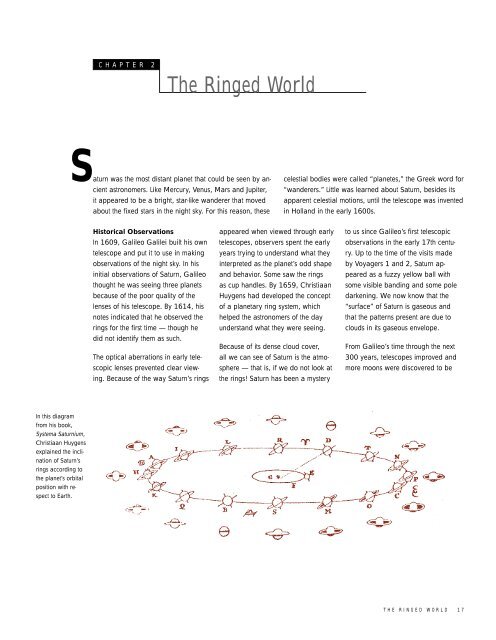Passage to a Ringed World - NASA's History Office
Passage to a Ringed World - NASA's History Office
Passage to a Ringed World - NASA's History Office
Create successful ePaper yourself
Turn your PDF publications into a flip-book with our unique Google optimized e-Paper software.
In this diagram<br />
from his book,<br />
Systema Saturnium,<br />
Christiaan Huygens<br />
explained the inclination<br />
of Saturn’s<br />
rings according <strong>to</strong><br />
the planet’s orbital<br />
position with respect<br />
<strong>to</strong> Earth.<br />
CHAPTER 2<br />
Saturn<br />
was the most distant planet that could be seen by an-<br />
cient astronomers. Like Mercury, Venus, Mars and Jupiter,<br />
it appeared <strong>to</strong> be a bright, star-like wanderer that moved<br />
about the fixed stars in the night sky. For this reason, these<br />
His<strong>to</strong>rical Observations<br />
In 1609, Galileo Galilei built his own<br />
telescope and put it <strong>to</strong> use in making<br />
observations of the night sky. In his<br />
initial observations of Saturn, Galileo<br />
thought he was seeing three planets<br />
because of the poor quality of the<br />
lenses of his telescope. By 1614, his<br />
notes indicated that he observed the<br />
rings for the first time — though he<br />
did not identify them as such.<br />
The optical aberrations in early telescopic<br />
lenses prevented clear viewing.<br />
Because of the way Saturn’s rings<br />
The <strong>Ringed</strong> <strong>World</strong><br />
appeared when viewed through early<br />
telescopes, observers spent the early<br />
years trying <strong>to</strong> understand what they<br />
interpreted as the planet’s odd shape<br />
and behavior. Some saw the rings<br />
as cup handles. By 1659, Christiaan<br />
Huygens had developed the concept<br />
of a planetary ring system, which<br />
helped the astronomers of the day<br />
understand what they were seeing.<br />
Because of its dense cloud cover,<br />
all we can see of Saturn is the atmosphere<br />
— that is, if we do not look at<br />
the rings! Saturn has been a mystery<br />
celestial bodies were called “planetes,” the Greek word for<br />
“wanderers.” Little was learned about Saturn, besides its<br />
apparent celestial motions, until the telescope was invented<br />
in Holland in the early 1600s.<br />
<strong>to</strong> us since Galileo’s first telescopic<br />
observations in the early 17th century.<br />
Up <strong>to</strong> the time of the visits made<br />
by Voyagers 1 and 2, Saturn appeared<br />
as a fuzzy yellow ball with<br />
some visible banding and some pole<br />
darkening. We now know that the<br />
“surface” of Saturn is gaseous and<br />
that the patterns present are due <strong>to</strong><br />
clouds in its gaseous envelope.<br />
From Galileo’s time through the next<br />
300 years, telescopes improved and<br />
more moons were discovered <strong>to</strong> be<br />
THE RINGED WORLD 17
















